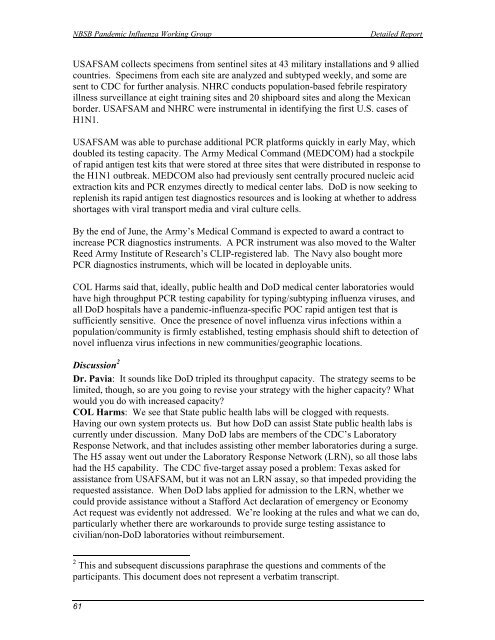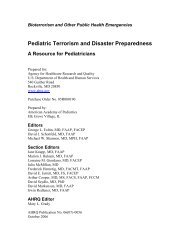H1N1 COUNTERMEASURES STRATEGY AND ... - PHE Home
H1N1 COUNTERMEASURES STRATEGY AND ... - PHE Home
H1N1 COUNTERMEASURES STRATEGY AND ... - PHE Home
Create successful ePaper yourself
Turn your PDF publications into a flip-book with our unique Google optimized e-Paper software.
NBSB Pandemic Influenza Working Group<br />
Detailed Report<br />
USAFSAM collects specimens from sentinel sites at 43 military installations and 9 allied<br />
countries. Specimens from each site are analyzed and subtyped weekly, and some are<br />
sent to CDC for further analysis. NHRC conducts population-based febrile respiratory<br />
illness surveillance at eight training sites and 20 shipboard sites and along the Mexican<br />
border. USAFSAM and NHRC were instrumental in identifying the first U.S. cases of<br />
<strong>H1N1</strong>.<br />
USAFSAM was able to purchase additional PCR platforms quickly in early May, which<br />
doubled its testing capacity. The Army Medical Command (MEDCOM) had a stockpile<br />
of rapid antigen test kits that were stored at three sites that were distributed in response to<br />
the <strong>H1N1</strong> outbreak. MEDCOM also had previously sent centrally procured nucleic acid<br />
extraction kits and PCR enzymes directly to medical center labs. DoD is now seeking to<br />
replenish its rapid antigen test diagnostics resources and is looking at whether to address<br />
shortages with viral transport media and viral culture cells.<br />
By the end of June, the Army’s Medical Command is expected to award a contract to<br />
increase PCR diagnostics instruments. A PCR instrument was also moved to the Walter<br />
Reed Army Institute of Research’s CLIP-registered lab. The Navy also bought more<br />
PCR diagnostics instruments, which will be located in deployable units.<br />
COL Harms said that, ideally, public health and DoD medical center laboratories would<br />
have high throughput PCR testing capability for typing/subtyping influenza viruses, and<br />
all DoD hospitals have a pandemic-influenza-specific POC rapid antigen test that is<br />
sufficiently sensitive. Once the presence of novel influenza virus infections within a<br />
population/community is firmly established, testing emphasis should shift to detection of<br />
novel influenza virus infections in new communities/geographic locations.<br />
Discussion 2<br />
Dr. Pavia: It sounds like DoD tripled its throughput capacity. The strategy seems to be<br />
limited, though, so are you going to revise your strategy with the higher capacity? What<br />
would you do with increased capacity?<br />
COL Harms: We see that State public health labs will be clogged with requests.<br />
Having our own system protects us. But how DoD can assist State public health labs is<br />
currently under discussion. Many DoD labs are members of the CDC’s Laboratory<br />
Response Network, and that includes assisting other member laboratories during a surge.<br />
The H5 assay went out under the Laboratory Response Network (LRN), so all those labs<br />
had the H5 capability. The CDC five-target assay posed a problem: Texas asked for<br />
assistance from USAFSAM, but it was not an LRN assay, so that impeded providing the<br />
requested assistance. When DoD labs applied for admission to the LRN, whether we<br />
could provide assistance without a Stafford Act declaration of emergency or Economy<br />
Act request was evidently not addressed. We’re looking at the rules and what we can do,<br />
particularly whether there are workarounds to provide surge testing assistance to<br />
civilian/non-DoD laboratories without reimbursement.<br />
2 This and subsequent discussions paraphrase the questions and comments of the<br />
participants. This document does not represent a verbatim transcript.<br />
61
















